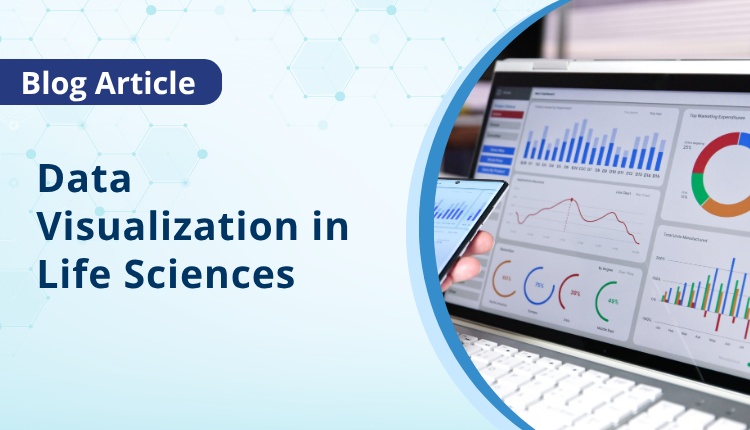Key Takeaways:
- The right visualization can boost comprehension, reproducibility, and impact in life sciences research.
- Tools like heatmaps, UpSet plots, and interactive dashboards are transforming static publishing norms.
- Following purpose-driven chart selection and visualization checklists ensures clarity and accessibility.
Executive Summary:
Data visualization in life sciences isn’t just about making figures look good—it’s about enhancing understanding, improving data integrity, and making research clearer, more engaging, and reproducible. Whether you’re illustrating gene expression, clinical outcomes, or epidemiological trends, choosing the right visualization format and following best-practice design principles can significantly improve your publication’s effectiveness and credibility.
What is Data Visualization in Life Sciences?
Data visualization in life sciences refers to the graphical representation of biological, clinical, or molecular data. They help researchers, clinicians, and readers interpret complex information more clearly.
From simple bar charts comparing treatment effects to interactive 3D renderings of spatial transcriptomics data, these visual tools bridge between raw data and actionable insights. They also reduce misinterpretation, facilitate peer review, and support reproducibility.
Why is Visualization Critical in Life Sciences Publications?
Because life sciences data is complex and multidimensional, good visualization is key to accurate interpretation and dissemination. It is essential for the readers to absorb experimental results quickly and evaluate conclusions critically. Well-designed visuals support this process by:
- Summarizing large datasets in digestible formats
- Highlighting statistical significance and trends
- Enabling side-by-side comparison of variables
- Supporting interactive exploration (especially in online supplements)
Poor visuals, on the other hand, can obscure findings, mislead readers, and contribute to retractions. Despite their significance, many figures fail to meet best practices. For instance, over a million life sciences manuscripts publish annually, but nearly two‑thirds of them include statistical figures that are poorly designed and confusing.
What Types of Charts Work Best for Different Research Goals?
Choosing the right chart starts with understanding your data’s story. Here’s a quick reference:
Purpose |
Best Chart Types |
Example Use |
| Compare categories | Bar chart, box plot | Protein expression across cell lines |
| Show distribution | Histogram, violin plot, box/whisker plot | Antibody titer variation across samples |
| Track trends over time | Line chart/graph | Patient response to a drug over 6 months |
| Examine correlation | Scatter plot (2 variables), bubble chart (3 variables) | Gene expression vs. phenotype correlation |
| Show intersections | UpSet plot, Venn diagram | Common genes in multiple conditions |
| Display intensity/matrix, frequencies of different activities | Heatmap, clustered heatmap | RNA-seq sample clustering |
| Visualize location/data | Geospatial maps, 3D imaging | COVID-19 spread by district |
Some Common and Powerful Charts
1. Scatter Plots
What: Graph displaying the relationship between two numerical variables
Used when: Visualizing large datasets with numerical pair of values
2. Line Graphs
What: Connects data points using straight line segments
Used when: Tracking changes over time with independent and dependent variables on x and y axis respectively
3. Heatmaps
What: Display magnitude of values using different intensities of a color across a matrix
Used when: Demonstrate relationships between two categorical or numerical variables and observe if there are any patterns in value for either or both of them
4. Box Plots
What: Distributes numerical data into quartiles
Used when: Show distribution of numeric data values
5. Histograms
What: Distributes numerical data to display frequency of numerical data within specified ranges
Used when: Analyzing continuous data ranges
6. UpSet Plots
What: Advanced alternative to Venn diagrams for many intersecting sets
Used when: Perform quantitative data analysis with more than three datasets
7. Geospatial & Temporal Dashboards
What: Interactive tools combining geographical information with time-based data
Used when: Visualize and analyze trends and patterns in a dynamic way
Exploring Complex Data With Interactive Visuals
Interactive dashboards and 3D/VR tools are making life sciences research more engaging, transparent, and reproducible. Instead of flat static figures, publishers are increasingly embracing:
- Linked dashboards for exploring time-series or multi-dimensional clinical data
- 3D reconstructions of microscopy or molecular structures
- Hover-based metadata display for complex plots (like volcano or forest plots)
These help reviewers, clinicians, and policymakers make more informed decisions and reduce misinterpretation.
Which Tools are Commonly Used for Life Sciences Data Visualization?
Researchers can choose from many tools based on complexity and coding experience:
Tool |
Type |
Best For |
| GraphPad Prism | GUI-based | Biostatistics, clinical comparisons |
| R (ggplot2) | Coding | Flexible, publication-quality plots |
| Python (Seaborn, Matplotlib, UpSetPlot) | Coding | Data-rich visualizations, custom dashboards |
| Tableau | GUI-based | Interactive dashboards, clinical data |
| Vaa3D | Domain-specific | 3D microscopy and spatial biology |
| Datawrapper | Web-based | Clean charts for non-coders |
| Flourish | Web-based | Interactive storytelling and charts |
What are Best-Practice Guidelines for Designing Effective Visuals?
- Choose the right chart for the goal—not popularity.
- Avoid misleading color schemes (e.g., avoid rainbow; use perceptually uniform colormaps like Viridis).
- Label clearly and minimally—use direct, data-rich titles and axis labels.
- Ensure readability across print and screen, including for color-blind readers.
- Use statistical annotation where necessary (e.g., asterisks for p-values, confidence intervals).
- Don’t distort axes—start bar charts from zero unless scientifically justified.
To promote transparency and compliance with FAIR (Findable, Accessible, Interoperable, Reusable) principles:
- Include original code or data for plot generation in supplements or repositories (e.g., GitHub, Zenodo).
- Use open formats (SVG, PDF, PNG) and avoid proprietary formats that limit access.
- Add alt text and structured captions that describe the visual to screen readers.
- Validate with accessibility checkers to ensure compatibility for color vision and screen readers.
Effective visualization is essential, more than aesthetic, it is central to clarity, impact, and reproducibility in life‑sciences publishing. Using a purpose-led framework, selecting appropriate plot types, adhering to established best-practices, and leveraging interactive tools empowers researchers to convert complex data into compelling, communicative science.
Author:

Anagha Nair
Editorial Assistant, Enago Academy
Medical Writer, Enago Life Sciences
Connect with Anagha on LinkedIn

